Culture and Psycho-sociology: Examining Societal and Cultural Impact
VerifiedAdded on 2023/06/03
|16
|4144
|118
Essay
AI Summary
This essay delves into the intricate relationship between culture and psycho-sociology, examining how societal and cultural factors shape human behavior and thought. It begins by highlighting the influence of multiculturalism and globalization on the development of psycho-social studies, emphasizing the role of technology in facilitating communication and shaping new ways of thinking. The essay explores various aspects of cultural diversity, including the impact of immigration, religion, and gender rights. It analyzes the dynamics of social psychological studies in the context of cultural influence, discussing the implications of technological advancements and urbanization. Furthermore, it examines the impact of multiculturalism, ethnic tensions, and immigration, including discussions on race, racism, and collective identity. The essay also explores the socio-psychological determinants of public acceptance of technologies and the evolving civilization, while also touching upon the roles of religion and culture in the United States. The paper suggests effective ways of interrelating these aspects, emphasizing the importance of critical thinking and social competence in navigating a diverse and globalized world.
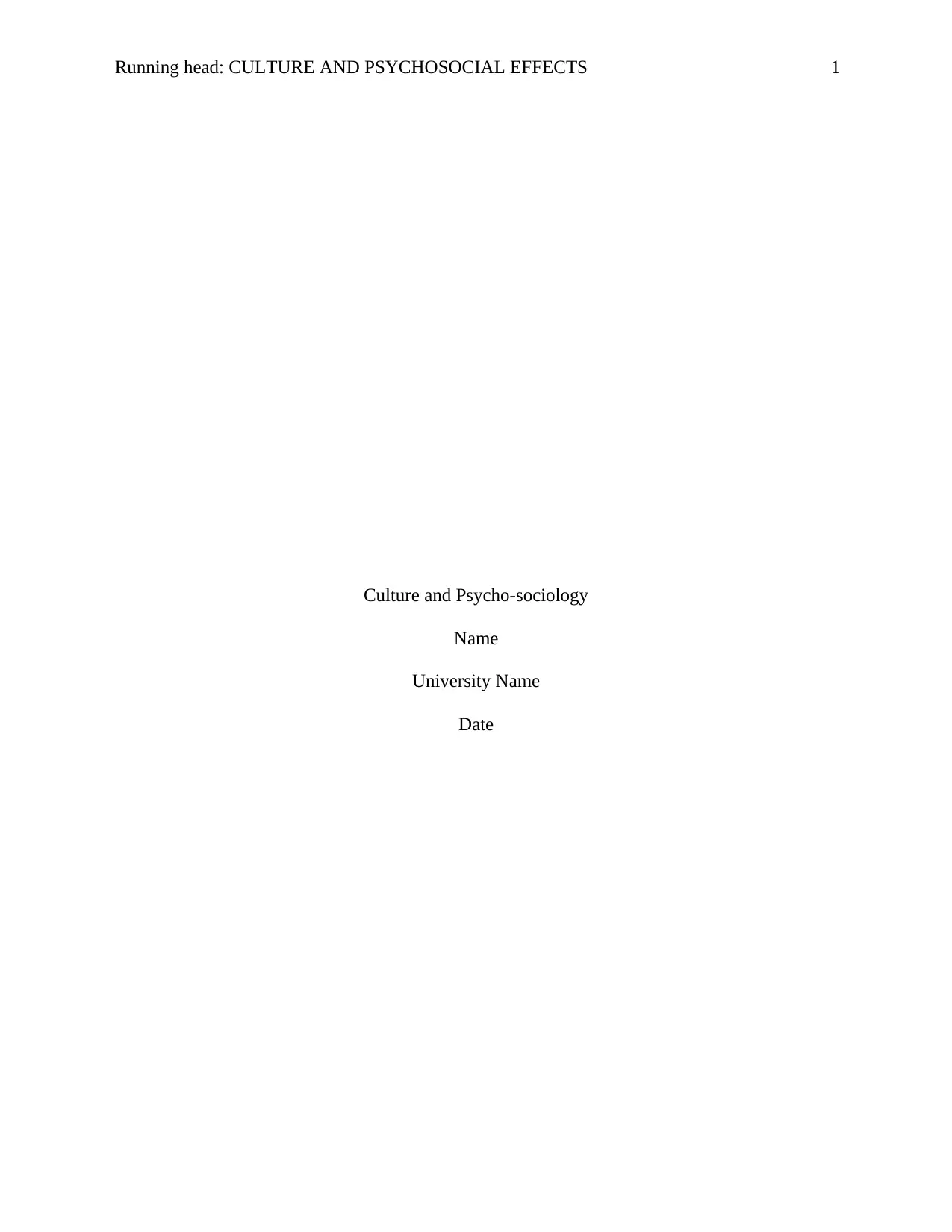
Running head: CULTURE AND PSYCHOSOCIAL EFFECTS 1
Culture and Psycho-sociology
Name
University Name
Date
Culture and Psycho-sociology
Name
University Name
Date
Paraphrase This Document
Need a fresh take? Get an instant paraphrase of this document with our AI Paraphraser
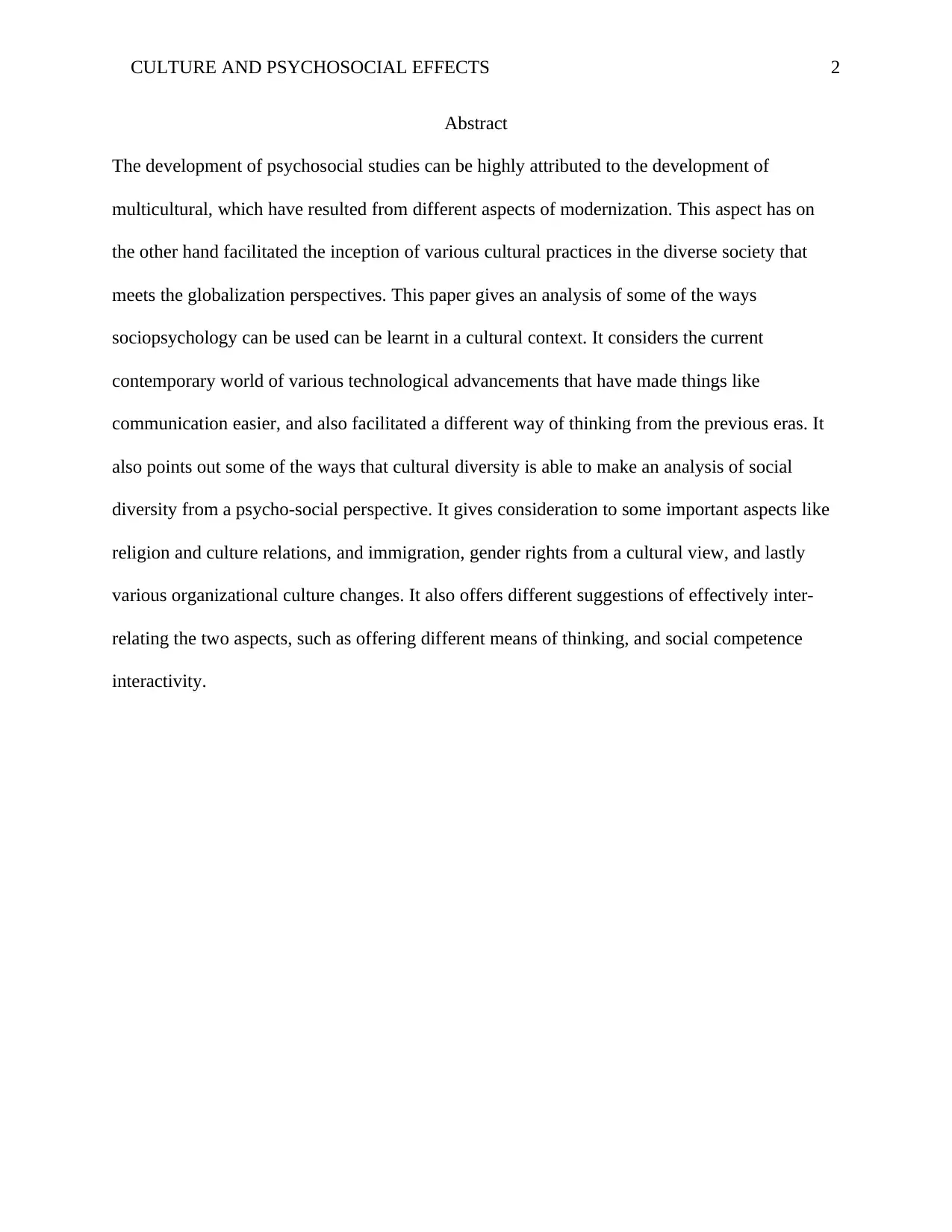
CULTURE AND PSYCHOSOCIAL EFFECTS 2
Abstract
The development of psychosocial studies can be highly attributed to the development of
multicultural, which have resulted from different aspects of modernization. This aspect has on
the other hand facilitated the inception of various cultural practices in the diverse society that
meets the globalization perspectives. This paper gives an analysis of some of the ways
sociopsychology can be used can be learnt in a cultural context. It considers the current
contemporary world of various technological advancements that have made things like
communication easier, and also facilitated a different way of thinking from the previous eras. It
also points out some of the ways that cultural diversity is able to make an analysis of social
diversity from a psycho-social perspective. It gives consideration to some important aspects like
religion and culture relations, and immigration, gender rights from a cultural view, and lastly
various organizational culture changes. It also offers different suggestions of effectively inter-
relating the two aspects, such as offering different means of thinking, and social competence
interactivity.
Abstract
The development of psychosocial studies can be highly attributed to the development of
multicultural, which have resulted from different aspects of modernization. This aspect has on
the other hand facilitated the inception of various cultural practices in the diverse society that
meets the globalization perspectives. This paper gives an analysis of some of the ways
sociopsychology can be used can be learnt in a cultural context. It considers the current
contemporary world of various technological advancements that have made things like
communication easier, and also facilitated a different way of thinking from the previous eras. It
also points out some of the ways that cultural diversity is able to make an analysis of social
diversity from a psycho-social perspective. It gives consideration to some important aspects like
religion and culture relations, and immigration, gender rights from a cultural view, and lastly
various organizational culture changes. It also offers different suggestions of effectively inter-
relating the two aspects, such as offering different means of thinking, and social competence
interactivity.
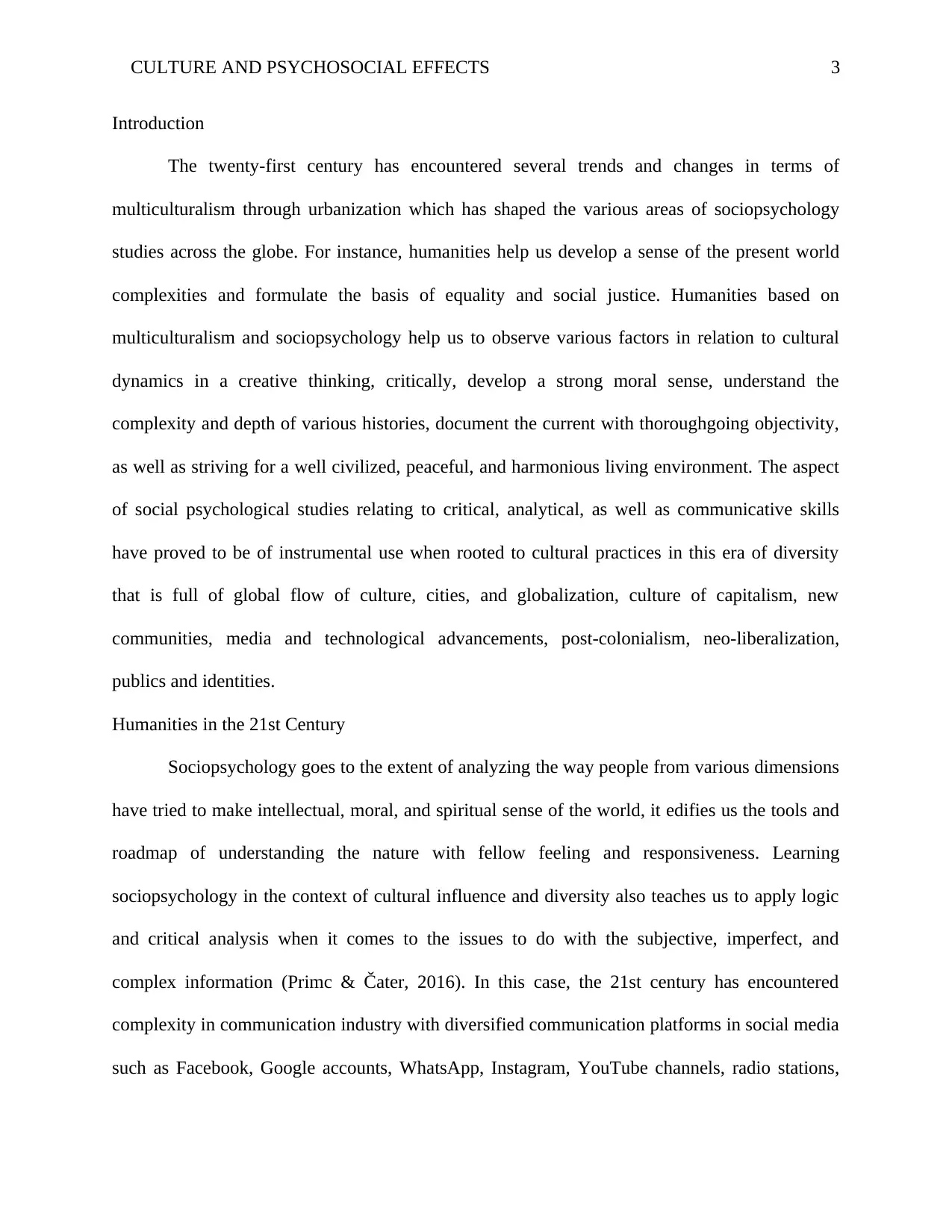
CULTURE AND PSYCHOSOCIAL EFFECTS 3
Introduction
The twenty-first century has encountered several trends and changes in terms of
multiculturalism through urbanization which has shaped the various areas of sociopsychology
studies across the globe. For instance, humanities help us develop a sense of the present world
complexities and formulate the basis of equality and social justice. Humanities based on
multiculturalism and sociopsychology help us to observe various factors in relation to cultural
dynamics in a creative thinking, critically, develop a strong moral sense, understand the
complexity and depth of various histories, document the current with thoroughgoing objectivity,
as well as striving for a well civilized, peaceful, and harmonious living environment. The aspect
of social psychological studies relating to critical, analytical, as well as communicative skills
have proved to be of instrumental use when rooted to cultural practices in this era of diversity
that is full of global flow of culture, cities, and globalization, culture of capitalism, new
communities, media and technological advancements, post-colonialism, neo-liberalization,
publics and identities.
Humanities in the 21st Century
Sociopsychology goes to the extent of analyzing the way people from various dimensions
have tried to make intellectual, moral, and spiritual sense of the world, it edifies us the tools and
roadmap of understanding the nature with fellow feeling and responsiveness. Learning
sociopsychology in the context of cultural influence and diversity also teaches us to apply logic
and critical analysis when it comes to the issues to do with the subjective, imperfect, and
complex information (Primc & Čater, 2016). In this case, the 21st century has encountered
complexity in communication industry with diversified communication platforms in social media
such as Facebook, Google accounts, WhatsApp, Instagram, YouTube channels, radio stations,
Introduction
The twenty-first century has encountered several trends and changes in terms of
multiculturalism through urbanization which has shaped the various areas of sociopsychology
studies across the globe. For instance, humanities help us develop a sense of the present world
complexities and formulate the basis of equality and social justice. Humanities based on
multiculturalism and sociopsychology help us to observe various factors in relation to cultural
dynamics in a creative thinking, critically, develop a strong moral sense, understand the
complexity and depth of various histories, document the current with thoroughgoing objectivity,
as well as striving for a well civilized, peaceful, and harmonious living environment. The aspect
of social psychological studies relating to critical, analytical, as well as communicative skills
have proved to be of instrumental use when rooted to cultural practices in this era of diversity
that is full of global flow of culture, cities, and globalization, culture of capitalism, new
communities, media and technological advancements, post-colonialism, neo-liberalization,
publics and identities.
Humanities in the 21st Century
Sociopsychology goes to the extent of analyzing the way people from various dimensions
have tried to make intellectual, moral, and spiritual sense of the world, it edifies us the tools and
roadmap of understanding the nature with fellow feeling and responsiveness. Learning
sociopsychology in the context of cultural influence and diversity also teaches us to apply logic
and critical analysis when it comes to the issues to do with the subjective, imperfect, and
complex information (Primc & Čater, 2016). In this case, the 21st century has encountered
complexity in communication industry with diversified communication platforms in social media
such as Facebook, Google accounts, WhatsApp, Instagram, YouTube channels, radio stations,
⊘ This is a preview!⊘
Do you want full access?
Subscribe today to unlock all pages.

Trusted by 1+ million students worldwide
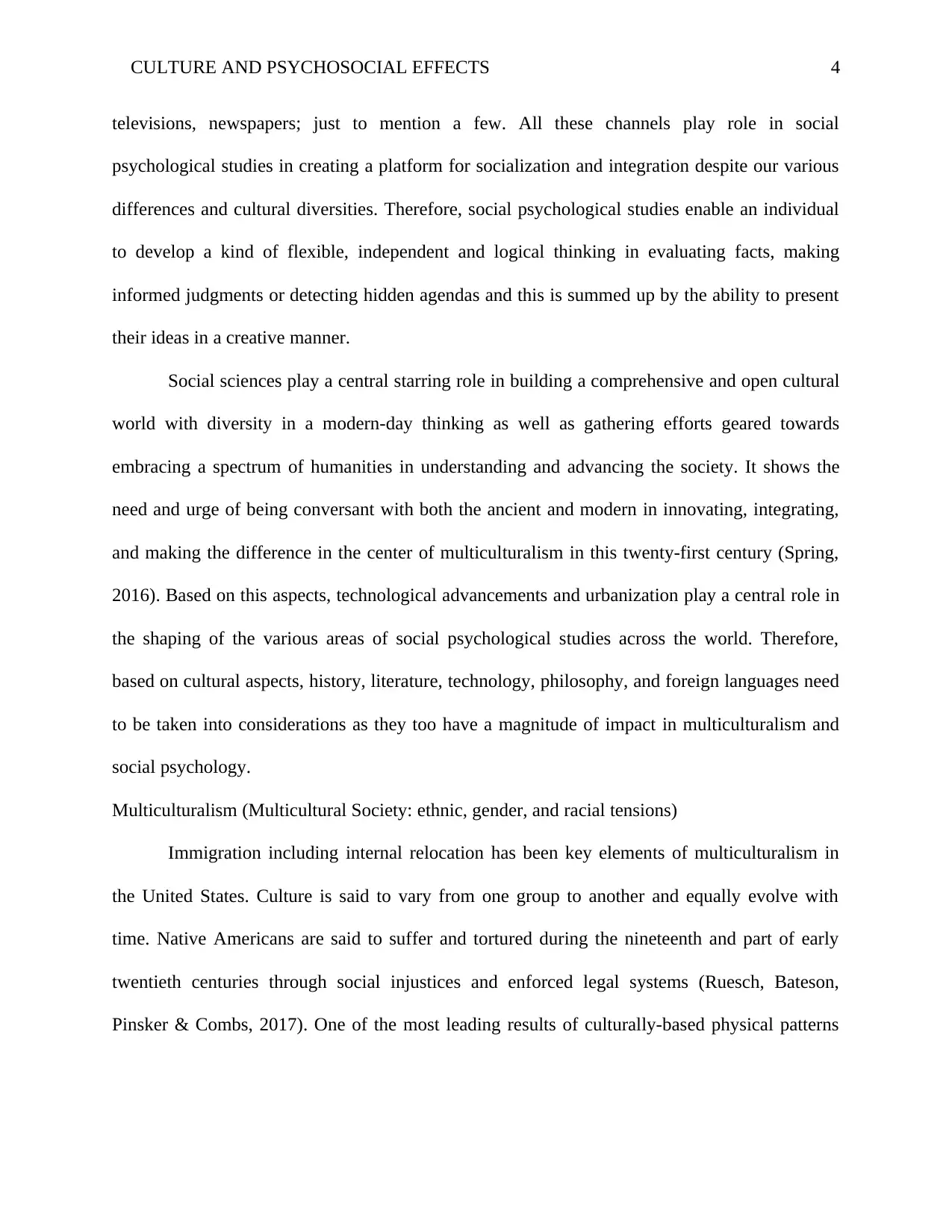
CULTURE AND PSYCHOSOCIAL EFFECTS 4
televisions, newspapers; just to mention a few. All these channels play role in social
psychological studies in creating a platform for socialization and integration despite our various
differences and cultural diversities. Therefore, social psychological studies enable an individual
to develop a kind of flexible, independent and logical thinking in evaluating facts, making
informed judgments or detecting hidden agendas and this is summed up by the ability to present
their ideas in a creative manner.
Social sciences play a central starring role in building a comprehensive and open cultural
world with diversity in a modern-day thinking as well as gathering efforts geared towards
embracing a spectrum of humanities in understanding and advancing the society. It shows the
need and urge of being conversant with both the ancient and modern in innovating, integrating,
and making the difference in the center of multiculturalism in this twenty-first century (Spring,
2016). Based on this aspects, technological advancements and urbanization play a central role in
the shaping of the various areas of social psychological studies across the world. Therefore,
based on cultural aspects, history, literature, technology, philosophy, and foreign languages need
to be taken into considerations as they too have a magnitude of impact in multiculturalism and
social psychology.
Multiculturalism (Multicultural Society: ethnic, gender, and racial tensions)
Immigration including internal relocation has been key elements of multiculturalism in
the United States. Culture is said to vary from one group to another and equally evolve with
time. Native Americans are said to suffer and tortured during the nineteenth and part of early
twentieth centuries through social injustices and enforced legal systems (Ruesch, Bateson,
Pinsker & Combs, 2017). One of the most leading results of culturally-based physical patterns
televisions, newspapers; just to mention a few. All these channels play role in social
psychological studies in creating a platform for socialization and integration despite our various
differences and cultural diversities. Therefore, social psychological studies enable an individual
to develop a kind of flexible, independent and logical thinking in evaluating facts, making
informed judgments or detecting hidden agendas and this is summed up by the ability to present
their ideas in a creative manner.
Social sciences play a central starring role in building a comprehensive and open cultural
world with diversity in a modern-day thinking as well as gathering efforts geared towards
embracing a spectrum of humanities in understanding and advancing the society. It shows the
need and urge of being conversant with both the ancient and modern in innovating, integrating,
and making the difference in the center of multiculturalism in this twenty-first century (Spring,
2016). Based on this aspects, technological advancements and urbanization play a central role in
the shaping of the various areas of social psychological studies across the world. Therefore,
based on cultural aspects, history, literature, technology, philosophy, and foreign languages need
to be taken into considerations as they too have a magnitude of impact in multiculturalism and
social psychology.
Multiculturalism (Multicultural Society: ethnic, gender, and racial tensions)
Immigration including internal relocation has been key elements of multiculturalism in
the United States. Culture is said to vary from one group to another and equally evolve with
time. Native Americans are said to suffer and tortured during the nineteenth and part of early
twentieth centuries through social injustices and enforced legal systems (Ruesch, Bateson,
Pinsker & Combs, 2017). One of the most leading results of culturally-based physical patterns
Paraphrase This Document
Need a fresh take? Get an instant paraphrase of this document with our AI Paraphraser
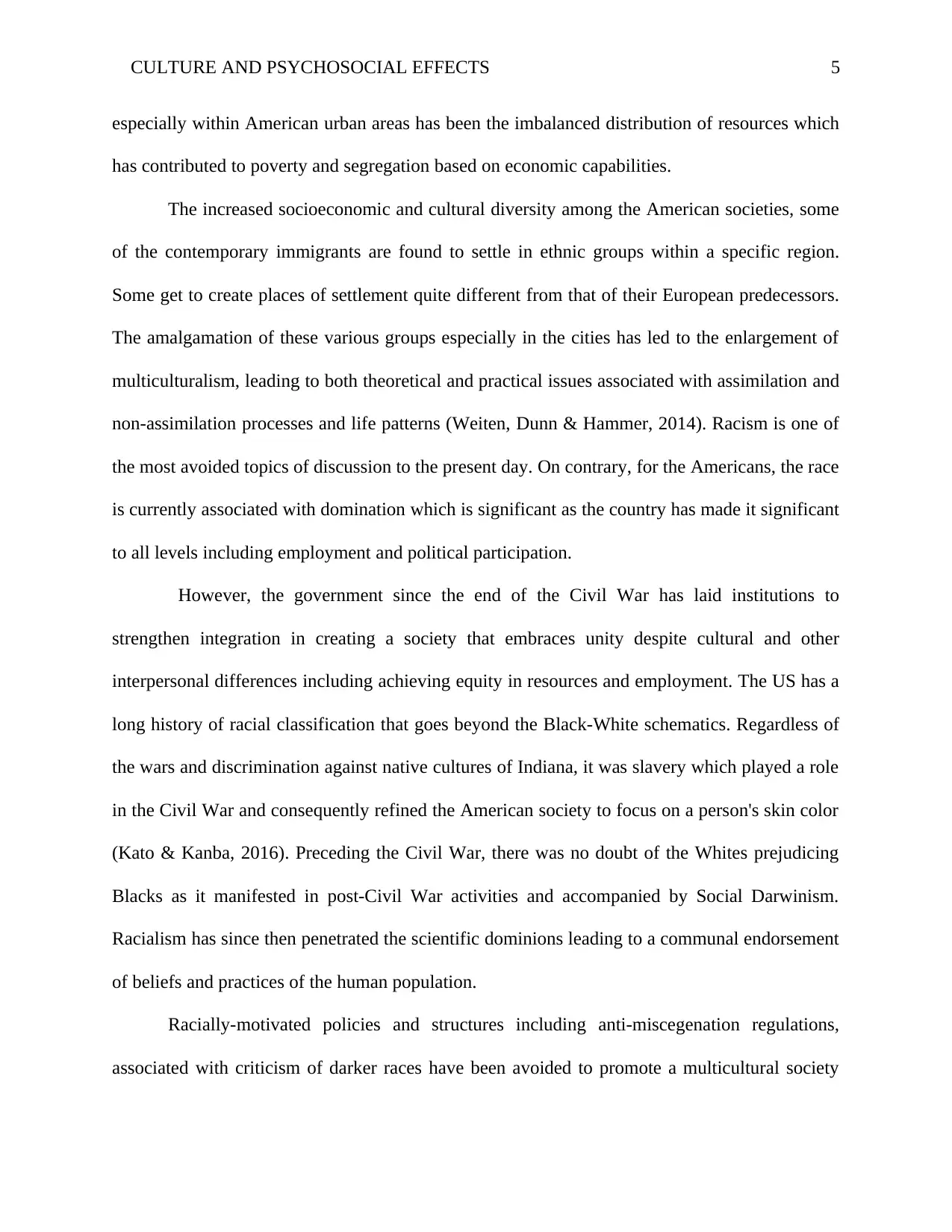
CULTURE AND PSYCHOSOCIAL EFFECTS 5
especially within American urban areas has been the imbalanced distribution of resources which
has contributed to poverty and segregation based on economic capabilities.
The increased socioeconomic and cultural diversity among the American societies, some
of the contemporary immigrants are found to settle in ethnic groups within a specific region.
Some get to create places of settlement quite different from that of their European predecessors.
The amalgamation of these various groups especially in the cities has led to the enlargement of
multiculturalism, leading to both theoretical and practical issues associated with assimilation and
non-assimilation processes and life patterns (Weiten, Dunn & Hammer, 2014). Racism is one of
the most avoided topics of discussion to the present day. On contrary, for the Americans, the race
is currently associated with domination which is significant as the country has made it significant
to all levels including employment and political participation.
However, the government since the end of the Civil War has laid institutions to
strengthen integration in creating a society that embraces unity despite cultural and other
interpersonal differences including achieving equity in resources and employment. The US has a
long history of racial classification that goes beyond the Black-White schematics. Regardless of
the wars and discrimination against native cultures of Indiana, it was slavery which played a role
in the Civil War and consequently refined the American society to focus on a person's skin color
(Kato & Kanba, 2016). Preceding the Civil War, there was no doubt of the Whites prejudicing
Blacks as it manifested in post-Civil War activities and accompanied by Social Darwinism.
Racialism has since then penetrated the scientific dominions leading to a communal endorsement
of beliefs and practices of the human population.
Racially-motivated policies and structures including anti-miscegenation regulations,
associated with criticism of darker races have been avoided to promote a multicultural society
especially within American urban areas has been the imbalanced distribution of resources which
has contributed to poverty and segregation based on economic capabilities.
The increased socioeconomic and cultural diversity among the American societies, some
of the contemporary immigrants are found to settle in ethnic groups within a specific region.
Some get to create places of settlement quite different from that of their European predecessors.
The amalgamation of these various groups especially in the cities has led to the enlargement of
multiculturalism, leading to both theoretical and practical issues associated with assimilation and
non-assimilation processes and life patterns (Weiten, Dunn & Hammer, 2014). Racism is one of
the most avoided topics of discussion to the present day. On contrary, for the Americans, the race
is currently associated with domination which is significant as the country has made it significant
to all levels including employment and political participation.
However, the government since the end of the Civil War has laid institutions to
strengthen integration in creating a society that embraces unity despite cultural and other
interpersonal differences including achieving equity in resources and employment. The US has a
long history of racial classification that goes beyond the Black-White schematics. Regardless of
the wars and discrimination against native cultures of Indiana, it was slavery which played a role
in the Civil War and consequently refined the American society to focus on a person's skin color
(Kato & Kanba, 2016). Preceding the Civil War, there was no doubt of the Whites prejudicing
Blacks as it manifested in post-Civil War activities and accompanied by Social Darwinism.
Racialism has since then penetrated the scientific dominions leading to a communal endorsement
of beliefs and practices of the human population.
Racially-motivated policies and structures including anti-miscegenation regulations,
associated with criticism of darker races have been avoided to promote a multicultural society
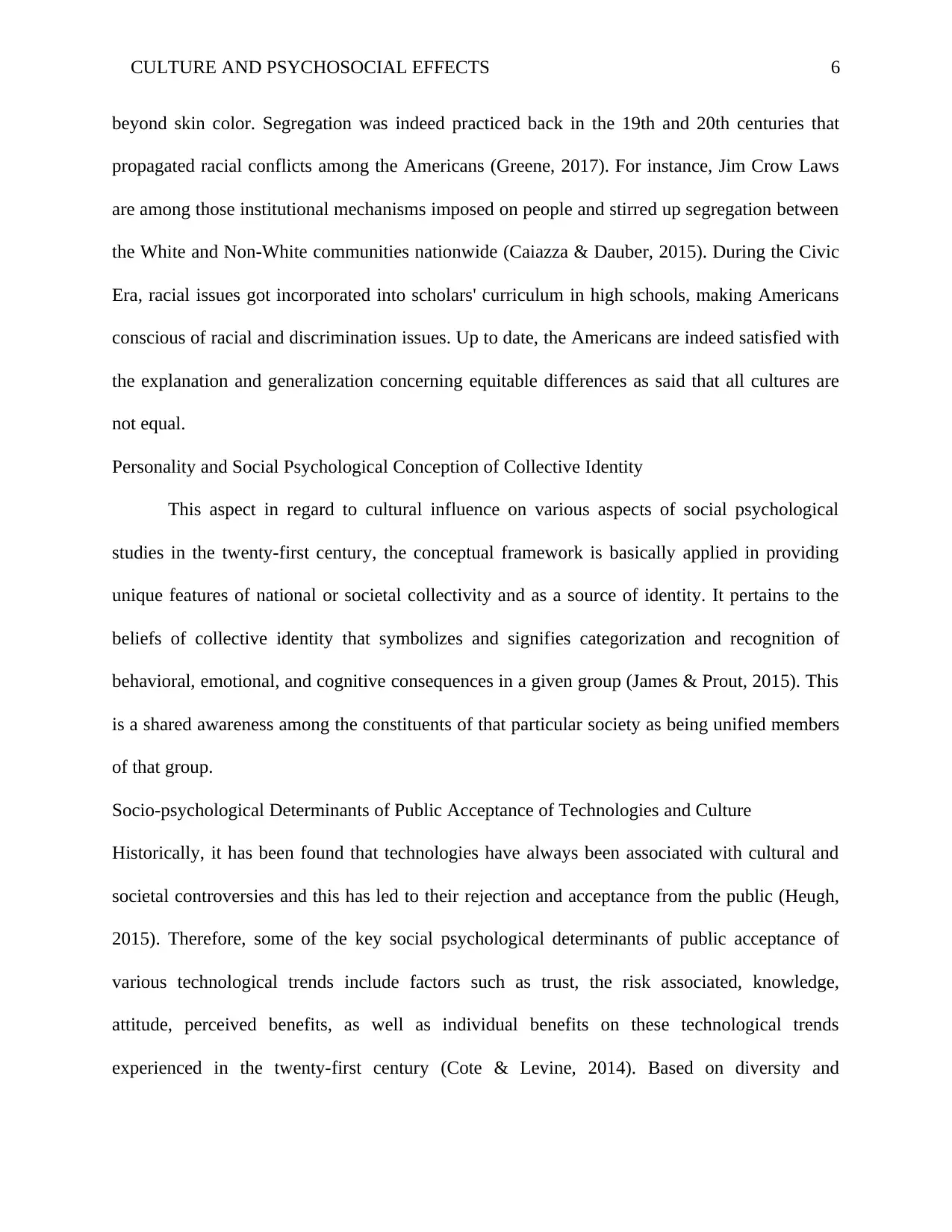
CULTURE AND PSYCHOSOCIAL EFFECTS 6
beyond skin color. Segregation was indeed practiced back in the 19th and 20th centuries that
propagated racial conflicts among the Americans (Greene, 2017). For instance, Jim Crow Laws
are among those institutional mechanisms imposed on people and stirred up segregation between
the White and Non-White communities nationwide (Caiazza & Dauber, 2015). During the Civic
Era, racial issues got incorporated into scholars' curriculum in high schools, making Americans
conscious of racial and discrimination issues. Up to date, the Americans are indeed satisfied with
the explanation and generalization concerning equitable differences as said that all cultures are
not equal.
Personality and Social Psychological Conception of Collective Identity
This aspect in regard to cultural influence on various aspects of social psychological
studies in the twenty-first century, the conceptual framework is basically applied in providing
unique features of national or societal collectivity and as a source of identity. It pertains to the
beliefs of collective identity that symbolizes and signifies categorization and recognition of
behavioral, emotional, and cognitive consequences in a given group (James & Prout, 2015). This
is a shared awareness among the constituents of that particular society as being unified members
of that group.
Socio-psychological Determinants of Public Acceptance of Technologies and Culture
Historically, it has been found that technologies have always been associated with cultural and
societal controversies and this has led to their rejection and acceptance from the public (Heugh,
2015). Therefore, some of the key social psychological determinants of public acceptance of
various technological trends include factors such as trust, the risk associated, knowledge,
attitude, perceived benefits, as well as individual benefits on these technological trends
experienced in the twenty-first century (Cote & Levine, 2014). Based on diversity and
beyond skin color. Segregation was indeed practiced back in the 19th and 20th centuries that
propagated racial conflicts among the Americans (Greene, 2017). For instance, Jim Crow Laws
are among those institutional mechanisms imposed on people and stirred up segregation between
the White and Non-White communities nationwide (Caiazza & Dauber, 2015). During the Civic
Era, racial issues got incorporated into scholars' curriculum in high schools, making Americans
conscious of racial and discrimination issues. Up to date, the Americans are indeed satisfied with
the explanation and generalization concerning equitable differences as said that all cultures are
not equal.
Personality and Social Psychological Conception of Collective Identity
This aspect in regard to cultural influence on various aspects of social psychological
studies in the twenty-first century, the conceptual framework is basically applied in providing
unique features of national or societal collectivity and as a source of identity. It pertains to the
beliefs of collective identity that symbolizes and signifies categorization and recognition of
behavioral, emotional, and cognitive consequences in a given group (James & Prout, 2015). This
is a shared awareness among the constituents of that particular society as being unified members
of that group.
Socio-psychological Determinants of Public Acceptance of Technologies and Culture
Historically, it has been found that technologies have always been associated with cultural and
societal controversies and this has led to their rejection and acceptance from the public (Heugh,
2015). Therefore, some of the key social psychological determinants of public acceptance of
various technological trends include factors such as trust, the risk associated, knowledge,
attitude, perceived benefits, as well as individual benefits on these technological trends
experienced in the twenty-first century (Cote & Levine, 2014). Based on diversity and
⊘ This is a preview!⊘
Do you want full access?
Subscribe today to unlock all pages.

Trusted by 1+ million students worldwide
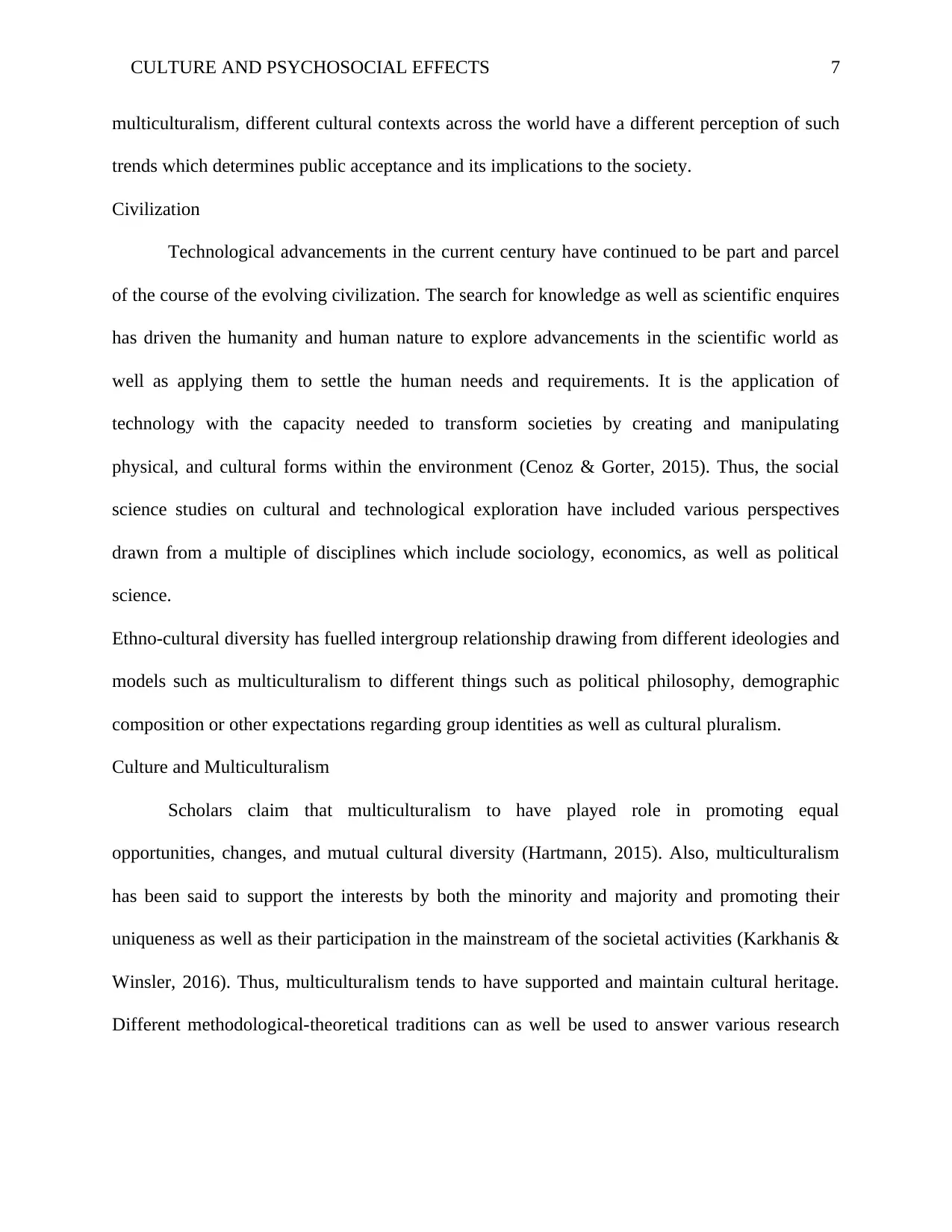
CULTURE AND PSYCHOSOCIAL EFFECTS 7
multiculturalism, different cultural contexts across the world have a different perception of such
trends which determines public acceptance and its implications to the society.
Civilization
Technological advancements in the current century have continued to be part and parcel
of the course of the evolving civilization. The search for knowledge as well as scientific enquires
has driven the humanity and human nature to explore advancements in the scientific world as
well as applying them to settle the human needs and requirements. It is the application of
technology with the capacity needed to transform societies by creating and manipulating
physical, and cultural forms within the environment (Cenoz & Gorter, 2015). Thus, the social
science studies on cultural and technological exploration have included various perspectives
drawn from a multiple of disciplines which include sociology, economics, as well as political
science.
Ethno-cultural diversity has fuelled intergroup relationship drawing from different ideologies and
models such as multiculturalism to different things such as political philosophy, demographic
composition or other expectations regarding group identities as well as cultural pluralism.
Culture and Multiculturalism
Scholars claim that multiculturalism to have played role in promoting equal
opportunities, changes, and mutual cultural diversity (Hartmann, 2015). Also, multiculturalism
has been said to support the interests by both the minority and majority and promoting their
uniqueness as well as their participation in the mainstream of the societal activities (Karkhanis &
Winsler, 2016). Thus, multiculturalism tends to have supported and maintain cultural heritage.
Different methodological-theoretical traditions can as well be used to answer various research
multiculturalism, different cultural contexts across the world have a different perception of such
trends which determines public acceptance and its implications to the society.
Civilization
Technological advancements in the current century have continued to be part and parcel
of the course of the evolving civilization. The search for knowledge as well as scientific enquires
has driven the humanity and human nature to explore advancements in the scientific world as
well as applying them to settle the human needs and requirements. It is the application of
technology with the capacity needed to transform societies by creating and manipulating
physical, and cultural forms within the environment (Cenoz & Gorter, 2015). Thus, the social
science studies on cultural and technological exploration have included various perspectives
drawn from a multiple of disciplines which include sociology, economics, as well as political
science.
Ethno-cultural diversity has fuelled intergroup relationship drawing from different ideologies and
models such as multiculturalism to different things such as political philosophy, demographic
composition or other expectations regarding group identities as well as cultural pluralism.
Culture and Multiculturalism
Scholars claim that multiculturalism to have played role in promoting equal
opportunities, changes, and mutual cultural diversity (Hartmann, 2015). Also, multiculturalism
has been said to support the interests by both the minority and majority and promoting their
uniqueness as well as their participation in the mainstream of the societal activities (Karkhanis &
Winsler, 2016). Thus, multiculturalism tends to have supported and maintain cultural heritage.
Different methodological-theoretical traditions can as well be used to answer various research
Paraphrase This Document
Need a fresh take? Get an instant paraphrase of this document with our AI Paraphraser
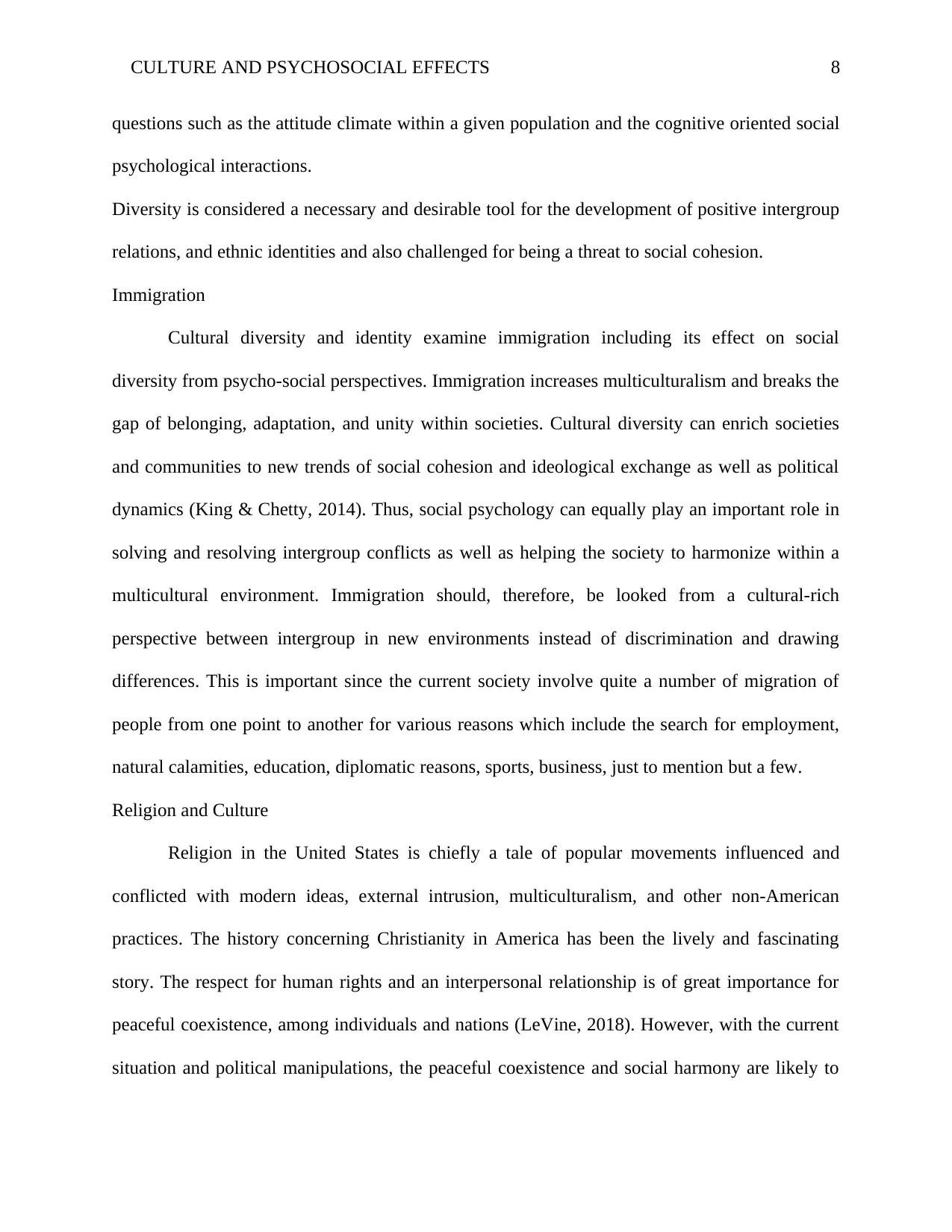
CULTURE AND PSYCHOSOCIAL EFFECTS 8
questions such as the attitude climate within a given population and the cognitive oriented social
psychological interactions.
Diversity is considered a necessary and desirable tool for the development of positive intergroup
relations, and ethnic identities and also challenged for being a threat to social cohesion.
Immigration
Cultural diversity and identity examine immigration including its effect on social
diversity from psycho-social perspectives. Immigration increases multiculturalism and breaks the
gap of belonging, adaptation, and unity within societies. Cultural diversity can enrich societies
and communities to new trends of social cohesion and ideological exchange as well as political
dynamics (King & Chetty, 2014). Thus, social psychology can equally play an important role in
solving and resolving intergroup conflicts as well as helping the society to harmonize within a
multicultural environment. Immigration should, therefore, be looked from a cultural-rich
perspective between intergroup in new environments instead of discrimination and drawing
differences. This is important since the current society involve quite a number of migration of
people from one point to another for various reasons which include the search for employment,
natural calamities, education, diplomatic reasons, sports, business, just to mention but a few.
Religion and Culture
Religion in the United States is chiefly a tale of popular movements influenced and
conflicted with modern ideas, external intrusion, multiculturalism, and other non-American
practices. The history concerning Christianity in America has been the lively and fascinating
story. The respect for human rights and an interpersonal relationship is of great importance for
peaceful coexistence, among individuals and nations (LeVine, 2018). However, with the current
situation and political manipulations, the peaceful coexistence and social harmony are likely to
questions such as the attitude climate within a given population and the cognitive oriented social
psychological interactions.
Diversity is considered a necessary and desirable tool for the development of positive intergroup
relations, and ethnic identities and also challenged for being a threat to social cohesion.
Immigration
Cultural diversity and identity examine immigration including its effect on social
diversity from psycho-social perspectives. Immigration increases multiculturalism and breaks the
gap of belonging, adaptation, and unity within societies. Cultural diversity can enrich societies
and communities to new trends of social cohesion and ideological exchange as well as political
dynamics (King & Chetty, 2014). Thus, social psychology can equally play an important role in
solving and resolving intergroup conflicts as well as helping the society to harmonize within a
multicultural environment. Immigration should, therefore, be looked from a cultural-rich
perspective between intergroup in new environments instead of discrimination and drawing
differences. This is important since the current society involve quite a number of migration of
people from one point to another for various reasons which include the search for employment,
natural calamities, education, diplomatic reasons, sports, business, just to mention but a few.
Religion and Culture
Religion in the United States is chiefly a tale of popular movements influenced and
conflicted with modern ideas, external intrusion, multiculturalism, and other non-American
practices. The history concerning Christianity in America has been the lively and fascinating
story. The respect for human rights and an interpersonal relationship is of great importance for
peaceful coexistence, among individuals and nations (LeVine, 2018). However, with the current
situation and political manipulations, the peaceful coexistence and social harmony are likely to
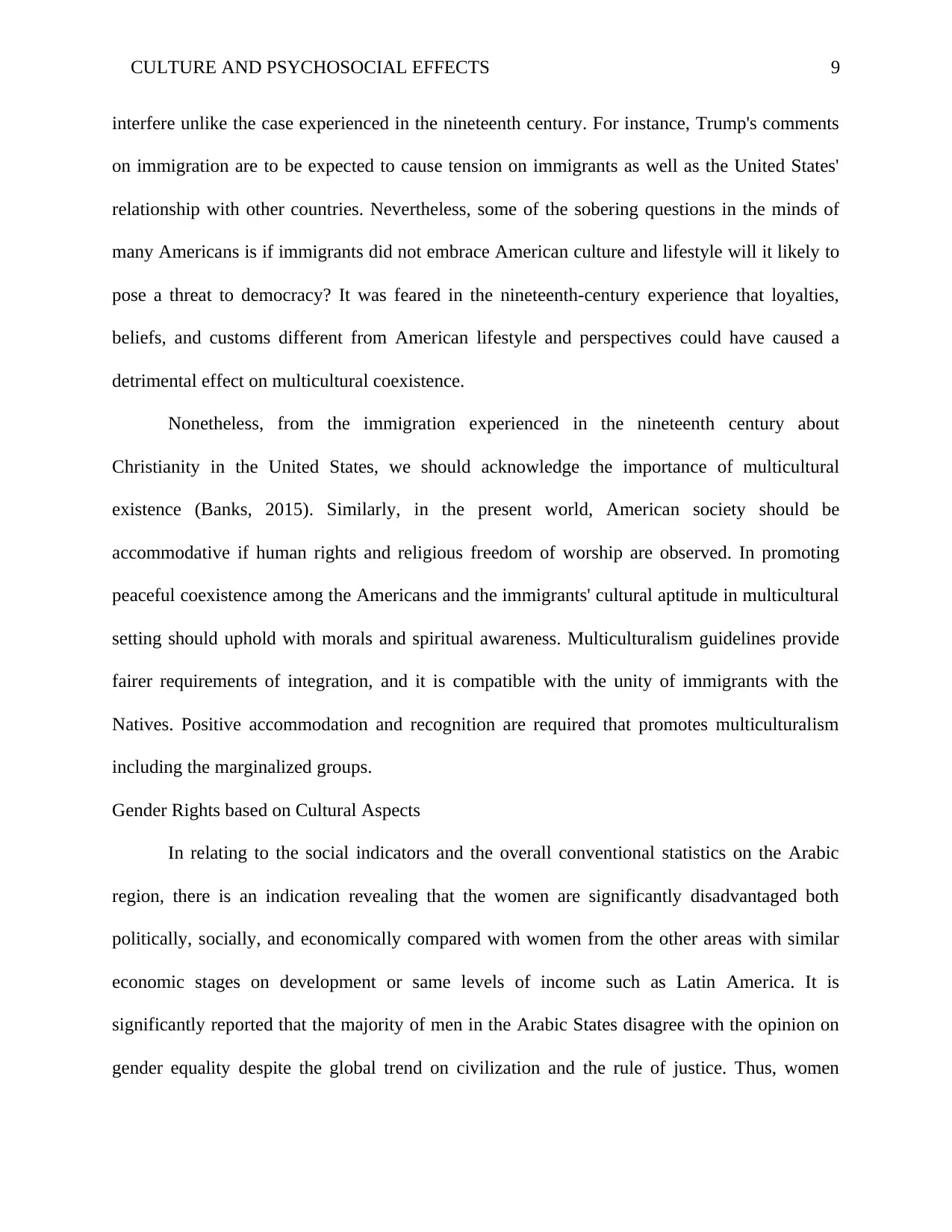
CULTURE AND PSYCHOSOCIAL EFFECTS 9
interfere unlike the case experienced in the nineteenth century. For instance, Trump's comments
on immigration are to be expected to cause tension on immigrants as well as the United States'
relationship with other countries. Nevertheless, some of the sobering questions in the minds of
many Americans is if immigrants did not embrace American culture and lifestyle will it likely to
pose a threat to democracy? It was feared in the nineteenth-century experience that loyalties,
beliefs, and customs different from American lifestyle and perspectives could have caused a
detrimental effect on multicultural coexistence.
Nonetheless, from the immigration experienced in the nineteenth century about
Christianity in the United States, we should acknowledge the importance of multicultural
existence (Banks, 2015). Similarly, in the present world, American society should be
accommodative if human rights and religious freedom of worship are observed. In promoting
peaceful coexistence among the Americans and the immigrants' cultural aptitude in multicultural
setting should uphold with morals and spiritual awareness. Multiculturalism guidelines provide
fairer requirements of integration, and it is compatible with the unity of immigrants with the
Natives. Positive accommodation and recognition are required that promotes multiculturalism
including the marginalized groups.
Gender Rights based on Cultural Aspects
In relating to the social indicators and the overall conventional statistics on the Arabic
region, there is an indication revealing that the women are significantly disadvantaged both
politically, socially, and economically compared with women from the other areas with similar
economic stages on development or same levels of income such as Latin America. It is
significantly reported that the majority of men in the Arabic States disagree with the opinion on
gender equality despite the global trend on civilization and the rule of justice. Thus, women
interfere unlike the case experienced in the nineteenth century. For instance, Trump's comments
on immigration are to be expected to cause tension on immigrants as well as the United States'
relationship with other countries. Nevertheless, some of the sobering questions in the minds of
many Americans is if immigrants did not embrace American culture and lifestyle will it likely to
pose a threat to democracy? It was feared in the nineteenth-century experience that loyalties,
beliefs, and customs different from American lifestyle and perspectives could have caused a
detrimental effect on multicultural coexistence.
Nonetheless, from the immigration experienced in the nineteenth century about
Christianity in the United States, we should acknowledge the importance of multicultural
existence (Banks, 2015). Similarly, in the present world, American society should be
accommodative if human rights and religious freedom of worship are observed. In promoting
peaceful coexistence among the Americans and the immigrants' cultural aptitude in multicultural
setting should uphold with morals and spiritual awareness. Multiculturalism guidelines provide
fairer requirements of integration, and it is compatible with the unity of immigrants with the
Natives. Positive accommodation and recognition are required that promotes multiculturalism
including the marginalized groups.
Gender Rights based on Cultural Aspects
In relating to the social indicators and the overall conventional statistics on the Arabic
region, there is an indication revealing that the women are significantly disadvantaged both
politically, socially, and economically compared with women from the other areas with similar
economic stages on development or same levels of income such as Latin America. It is
significantly reported that the majority of men in the Arabic States disagree with the opinion on
gender equality despite the global trend on civilization and the rule of justice. Thus, women
⊘ This is a preview!⊘
Do you want full access?
Subscribe today to unlock all pages.

Trusted by 1+ million students worldwide
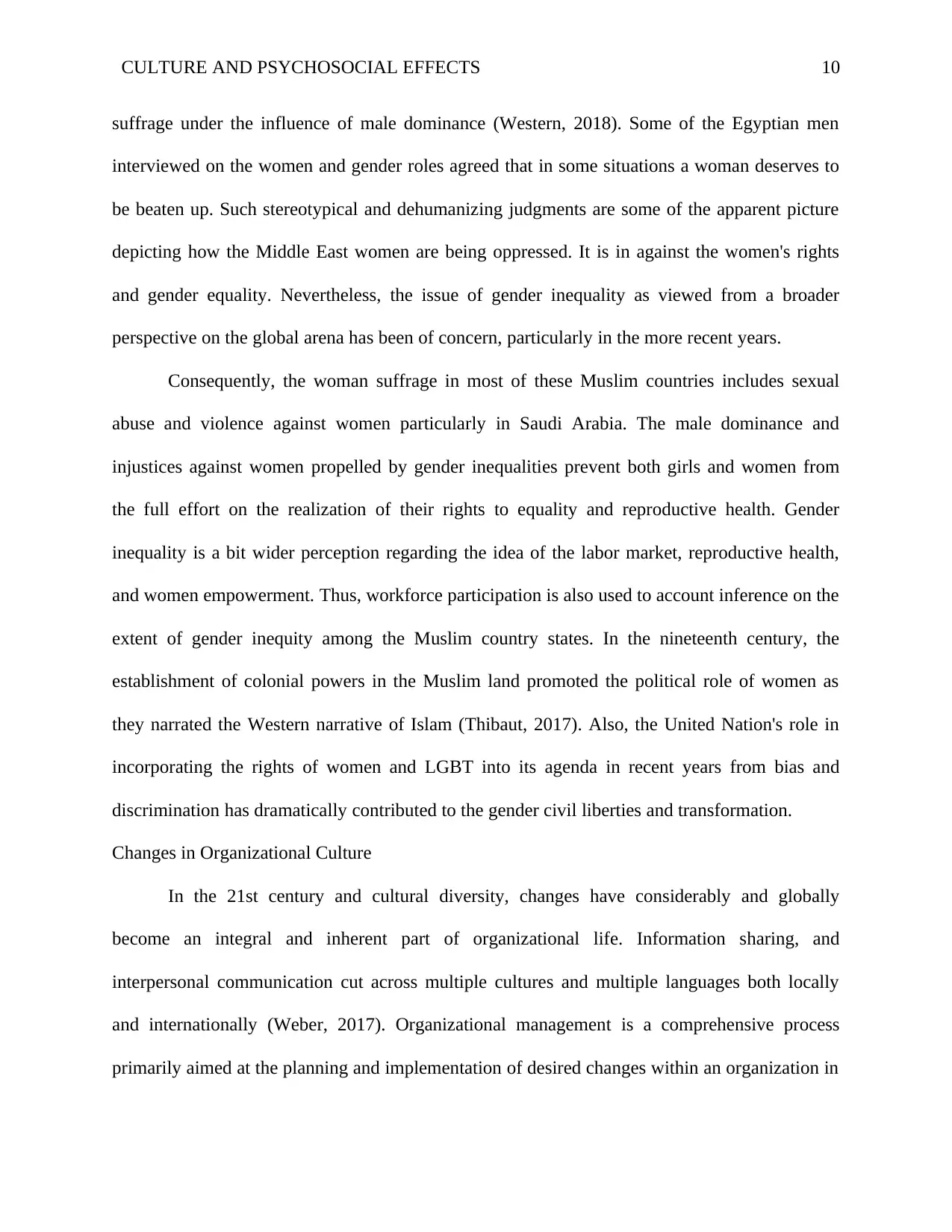
CULTURE AND PSYCHOSOCIAL EFFECTS 10
suffrage under the influence of male dominance (Western, 2018). Some of the Egyptian men
interviewed on the women and gender roles agreed that in some situations a woman deserves to
be beaten up. Such stereotypical and dehumanizing judgments are some of the apparent picture
depicting how the Middle East women are being oppressed. It is in against the women's rights
and gender equality. Nevertheless, the issue of gender inequality as viewed from a broader
perspective on the global arena has been of concern, particularly in the more recent years.
Consequently, the woman suffrage in most of these Muslim countries includes sexual
abuse and violence against women particularly in Saudi Arabia. The male dominance and
injustices against women propelled by gender inequalities prevent both girls and women from
the full effort on the realization of their rights to equality and reproductive health. Gender
inequality is a bit wider perception regarding the idea of the labor market, reproductive health,
and women empowerment. Thus, workforce participation is also used to account inference on the
extent of gender inequity among the Muslim country states. In the nineteenth century, the
establishment of colonial powers in the Muslim land promoted the political role of women as
they narrated the Western narrative of Islam (Thibaut, 2017). Also, the United Nation's role in
incorporating the rights of women and LGBT into its agenda in recent years from bias and
discrimination has dramatically contributed to the gender civil liberties and transformation.
Changes in Organizational Culture
In the 21st century and cultural diversity, changes have considerably and globally
become an integral and inherent part of organizational life. Information sharing, and
interpersonal communication cut across multiple cultures and multiple languages both locally
and internationally (Weber, 2017). Organizational management is a comprehensive process
primarily aimed at the planning and implementation of desired changes within an organization in
suffrage under the influence of male dominance (Western, 2018). Some of the Egyptian men
interviewed on the women and gender roles agreed that in some situations a woman deserves to
be beaten up. Such stereotypical and dehumanizing judgments are some of the apparent picture
depicting how the Middle East women are being oppressed. It is in against the women's rights
and gender equality. Nevertheless, the issue of gender inequality as viewed from a broader
perspective on the global arena has been of concern, particularly in the more recent years.
Consequently, the woman suffrage in most of these Muslim countries includes sexual
abuse and violence against women particularly in Saudi Arabia. The male dominance and
injustices against women propelled by gender inequalities prevent both girls and women from
the full effort on the realization of their rights to equality and reproductive health. Gender
inequality is a bit wider perception regarding the idea of the labor market, reproductive health,
and women empowerment. Thus, workforce participation is also used to account inference on the
extent of gender inequity among the Muslim country states. In the nineteenth century, the
establishment of colonial powers in the Muslim land promoted the political role of women as
they narrated the Western narrative of Islam (Thibaut, 2017). Also, the United Nation's role in
incorporating the rights of women and LGBT into its agenda in recent years from bias and
discrimination has dramatically contributed to the gender civil liberties and transformation.
Changes in Organizational Culture
In the 21st century and cultural diversity, changes have considerably and globally
become an integral and inherent part of organizational life. Information sharing, and
interpersonal communication cut across multiple cultures and multiple languages both locally
and internationally (Weber, 2017). Organizational management is a comprehensive process
primarily aimed at the planning and implementation of desired changes within an organization in
Paraphrase This Document
Need a fresh take? Get an instant paraphrase of this document with our AI Paraphraser
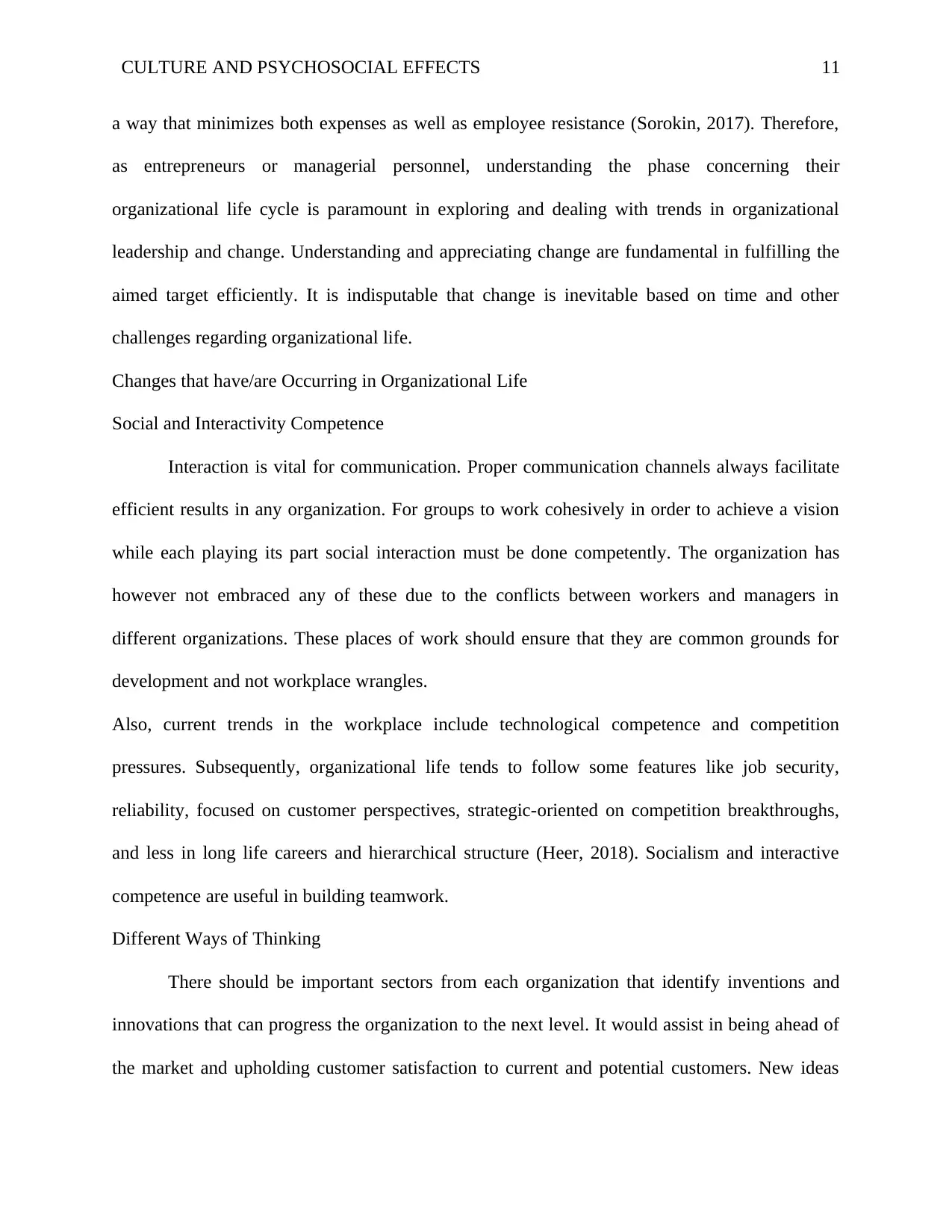
CULTURE AND PSYCHOSOCIAL EFFECTS 11
a way that minimizes both expenses as well as employee resistance (Sorokin, 2017). Therefore,
as entrepreneurs or managerial personnel, understanding the phase concerning their
organizational life cycle is paramount in exploring and dealing with trends in organizational
leadership and change. Understanding and appreciating change are fundamental in fulfilling the
aimed target efficiently. It is indisputable that change is inevitable based on time and other
challenges regarding organizational life.
Changes that have/are Occurring in Organizational Life
Social and Interactivity Competence
Interaction is vital for communication. Proper communication channels always facilitate
efficient results in any organization. For groups to work cohesively in order to achieve a vision
while each playing its part social interaction must be done competently. The organization has
however not embraced any of these due to the conflicts between workers and managers in
different organizations. These places of work should ensure that they are common grounds for
development and not workplace wrangles.
Also, current trends in the workplace include technological competence and competition
pressures. Subsequently, organizational life tends to follow some features like job security,
reliability, focused on customer perspectives, strategic-oriented on competition breakthroughs,
and less in long life careers and hierarchical structure (Heer, 2018). Socialism and interactive
competence are useful in building teamwork.
Different Ways of Thinking
There should be important sectors from each organization that identify inventions and
innovations that can progress the organization to the next level. It would assist in being ahead of
the market and upholding customer satisfaction to current and potential customers. New ideas
a way that minimizes both expenses as well as employee resistance (Sorokin, 2017). Therefore,
as entrepreneurs or managerial personnel, understanding the phase concerning their
organizational life cycle is paramount in exploring and dealing with trends in organizational
leadership and change. Understanding and appreciating change are fundamental in fulfilling the
aimed target efficiently. It is indisputable that change is inevitable based on time and other
challenges regarding organizational life.
Changes that have/are Occurring in Organizational Life
Social and Interactivity Competence
Interaction is vital for communication. Proper communication channels always facilitate
efficient results in any organization. For groups to work cohesively in order to achieve a vision
while each playing its part social interaction must be done competently. The organization has
however not embraced any of these due to the conflicts between workers and managers in
different organizations. These places of work should ensure that they are common grounds for
development and not workplace wrangles.
Also, current trends in the workplace include technological competence and competition
pressures. Subsequently, organizational life tends to follow some features like job security,
reliability, focused on customer perspectives, strategic-oriented on competition breakthroughs,
and less in long life careers and hierarchical structure (Heer, 2018). Socialism and interactive
competence are useful in building teamwork.
Different Ways of Thinking
There should be important sectors from each organization that identify inventions and
innovations that can progress the organization to the next level. It would assist in being ahead of
the market and upholding customer satisfaction to current and potential customers. New ideas
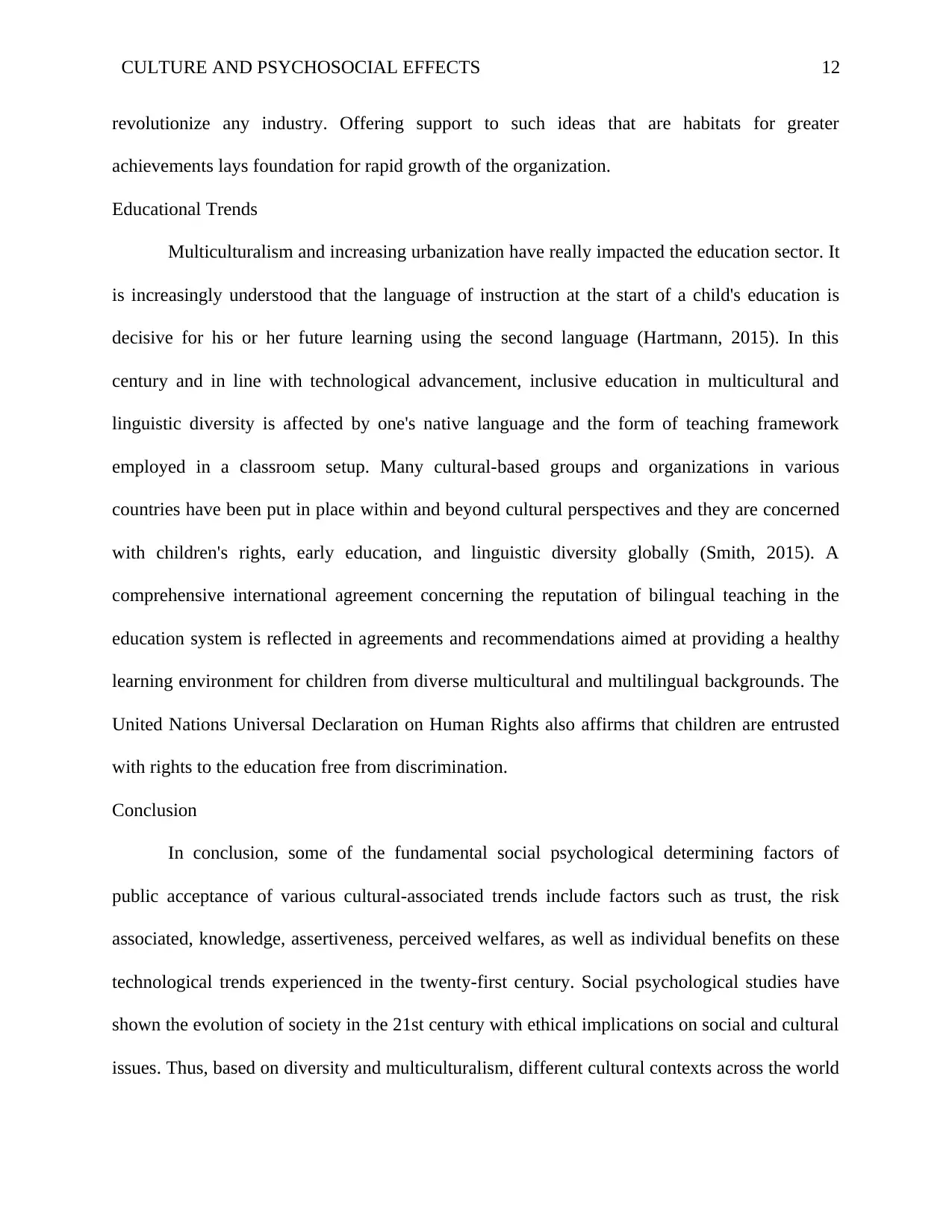
CULTURE AND PSYCHOSOCIAL EFFECTS 12
revolutionize any industry. Offering support to such ideas that are habitats for greater
achievements lays foundation for rapid growth of the organization.
Educational Trends
Multiculturalism and increasing urbanization have really impacted the education sector. It
is increasingly understood that the language of instruction at the start of a child's education is
decisive for his or her future learning using the second language (Hartmann, 2015). In this
century and in line with technological advancement, inclusive education in multicultural and
linguistic diversity is affected by one's native language and the form of teaching framework
employed in a classroom setup. Many cultural-based groups and organizations in various
countries have been put in place within and beyond cultural perspectives and they are concerned
with children's rights, early education, and linguistic diversity globally (Smith, 2015). A
comprehensive international agreement concerning the reputation of bilingual teaching in the
education system is reflected in agreements and recommendations aimed at providing a healthy
learning environment for children from diverse multicultural and multilingual backgrounds. The
United Nations Universal Declaration on Human Rights also affirms that children are entrusted
with rights to the education free from discrimination.
Conclusion
In conclusion, some of the fundamental social psychological determining factors of
public acceptance of various cultural-associated trends include factors such as trust, the risk
associated, knowledge, assertiveness, perceived welfares, as well as individual benefits on these
technological trends experienced in the twenty-first century. Social psychological studies have
shown the evolution of society in the 21st century with ethical implications on social and cultural
issues. Thus, based on diversity and multiculturalism, different cultural contexts across the world
revolutionize any industry. Offering support to such ideas that are habitats for greater
achievements lays foundation for rapid growth of the organization.
Educational Trends
Multiculturalism and increasing urbanization have really impacted the education sector. It
is increasingly understood that the language of instruction at the start of a child's education is
decisive for his or her future learning using the second language (Hartmann, 2015). In this
century and in line with technological advancement, inclusive education in multicultural and
linguistic diversity is affected by one's native language and the form of teaching framework
employed in a classroom setup. Many cultural-based groups and organizations in various
countries have been put in place within and beyond cultural perspectives and they are concerned
with children's rights, early education, and linguistic diversity globally (Smith, 2015). A
comprehensive international agreement concerning the reputation of bilingual teaching in the
education system is reflected in agreements and recommendations aimed at providing a healthy
learning environment for children from diverse multicultural and multilingual backgrounds. The
United Nations Universal Declaration on Human Rights also affirms that children are entrusted
with rights to the education free from discrimination.
Conclusion
In conclusion, some of the fundamental social psychological determining factors of
public acceptance of various cultural-associated trends include factors such as trust, the risk
associated, knowledge, assertiveness, perceived welfares, as well as individual benefits on these
technological trends experienced in the twenty-first century. Social psychological studies have
shown the evolution of society in the 21st century with ethical implications on social and cultural
issues. Thus, based on diversity and multiculturalism, different cultural contexts across the world
⊘ This is a preview!⊘
Do you want full access?
Subscribe today to unlock all pages.

Trusted by 1+ million students worldwide
1 out of 16
Related Documents
Your All-in-One AI-Powered Toolkit for Academic Success.
+13062052269
info@desklib.com
Available 24*7 on WhatsApp / Email
![[object Object]](/_next/static/media/star-bottom.7253800d.svg)
Unlock your academic potential
Copyright © 2020–2025 A2Z Services. All Rights Reserved. Developed and managed by ZUCOL.





